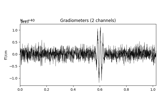mne.time_frequency.tfr_array_morlet#
- mne.time_frequency.tfr_array_morlet(epoch_data, sfreq, freqs, n_cycles=7.0, zero_mean=False, use_fft=True, decim=1, output='complex', n_jobs=None, verbose=None)[source]#
Compute Time-Frequency Representation (TFR) using Morlet wavelets.
Same computation as
tfr_morlet, but operates onNumPy arraysinstead ofEpochsobjects.- Parameters:
- epoch_data
arrayof shape (n_epochs, n_channels, n_times) The epochs.
- sfreq
float|int Sampling frequency of the data.
- freqsarray_like of
float, shape (n_freqs,) The frequencies.
- n_cycles
float|arrayoffloat, default 7.0 Number of cycles in the Morlet wavelet. Fixed number or one per frequency.
- zero_mean
bool|False If True, make sure the wavelets have a mean of zero. default False.
- use_fft
bool Use the FFT for convolutions or not. default True.
- decim
int|slice To reduce memory usage, decimation factor after time-frequency decomposition. default 1 If
int, returns tfr[…, ::decim]. Ifslice, returns tfr[…, decim].Note
Decimation may create aliasing artifacts, yet decimation is done after the convolutions.
- output
str, default ‘complex’ ‘complex’ : single trial complex.
‘power’ : single trial power.
‘phase’ : single trial phase.
‘avg_power’ : average of single trial power.
‘itc’ : inter-trial coherence.
‘avg_power_itc’ : average of single trial power and inter-trial coherence across trials.
- n_jobs
int|None The number of jobs to run in parallel. If
-1, it is set to the number of CPU cores. Requires thejoblibpackage.None(default) is a marker for ‘unset’ that will be interpreted asn_jobs=1(sequential execution) unless the call is performed under ajoblib.parallel_backend()context manager that sets another value forn_jobs. The number of epochs to process at the same time. The parallelization is implemented across channels. Default 1.- verbose
bool|str|int|None Control verbosity of the logging output. If
None, use the default verbosity level. See the logging documentation andmne.verbose()for details. Should only be passed as a keyword argument.
- epoch_data
- Returns:
- out
array Time frequency transform of epoch_data. If output is in [‘complex’, ‘phase’, ‘power’], then shape of out is (n_epochs, n_chans, n_freqs, n_times), else it is (n_chans, n_freqs, n_times). If output is ‘avg_power_itc’, the real values code for ‘avg_power’ and the imaginary values code for the ‘itc’: out = avg_power + i * itc.
- out
See also
Notes
New in version 0.14.0.
Examples using mne.time_frequency.tfr_array_morlet#

Time-frequency on simulated data (Multitaper vs. Morlet vs. Stockwell vs. Hilbert)